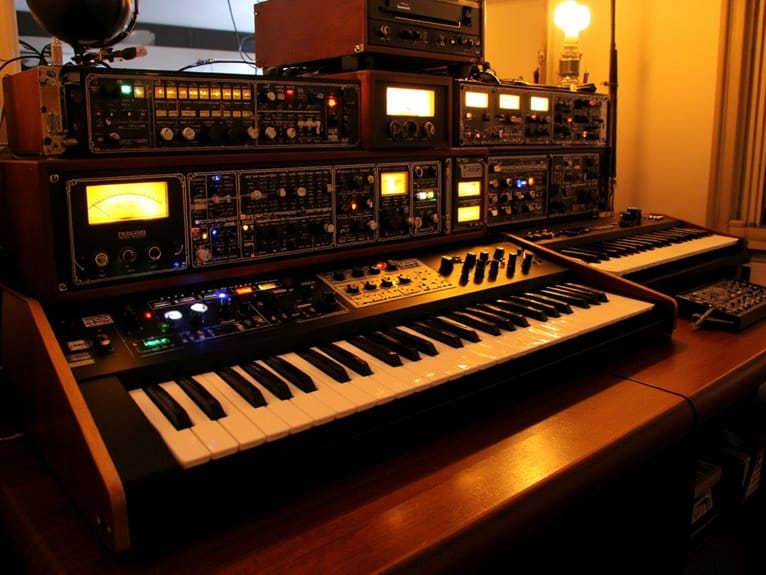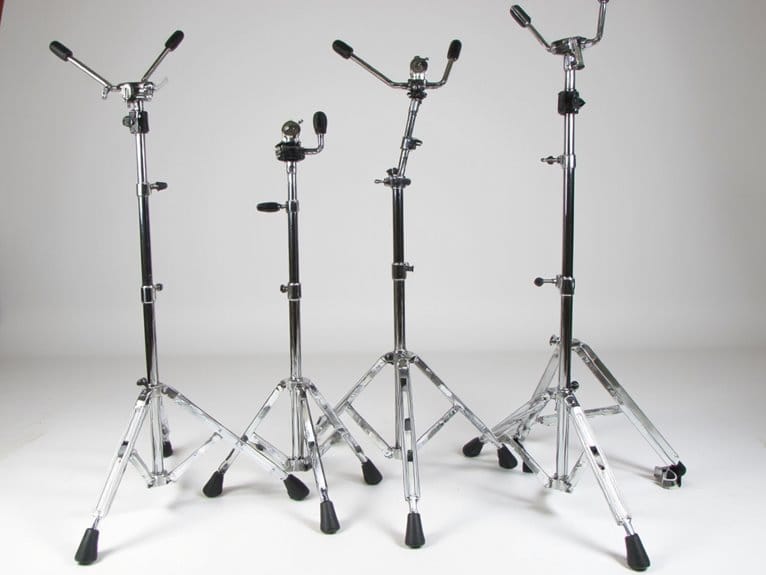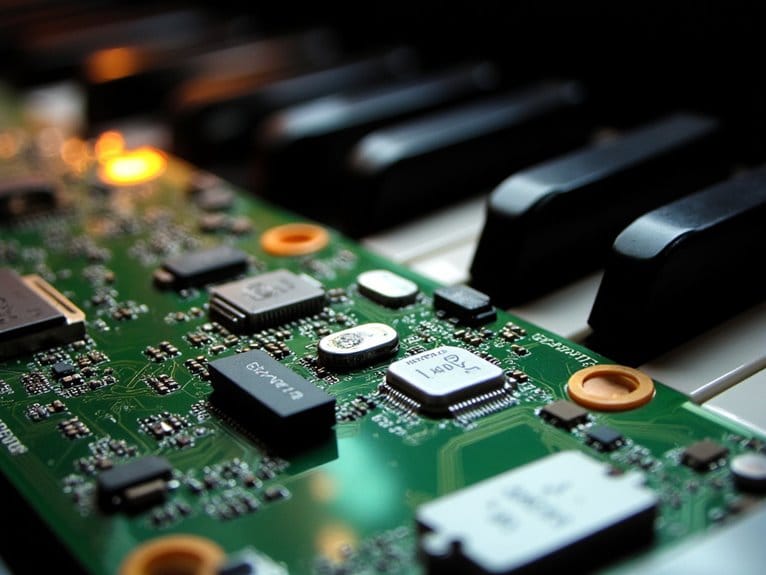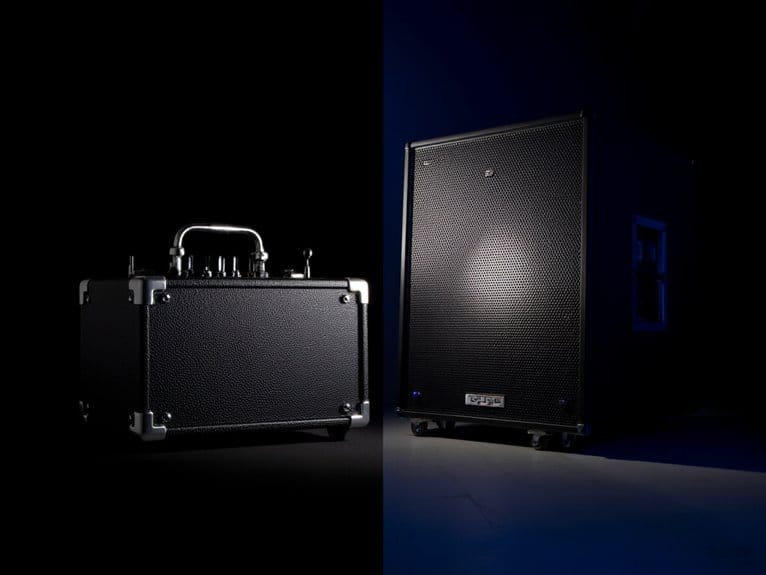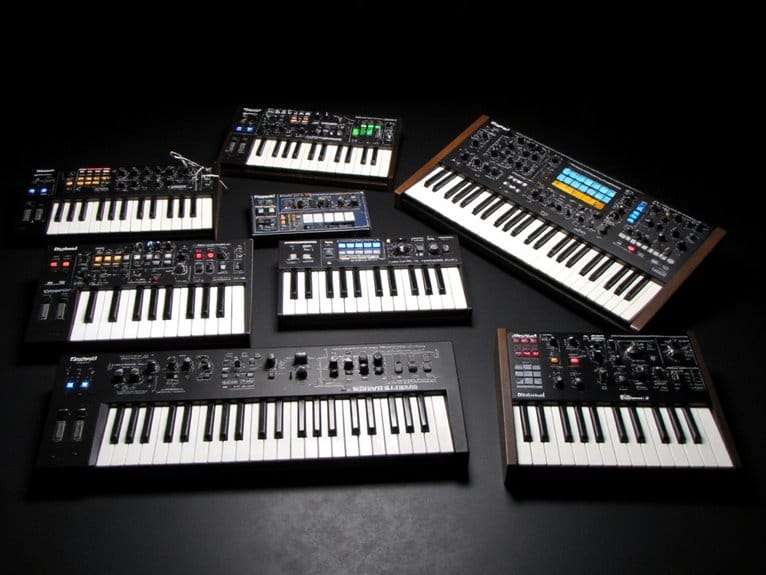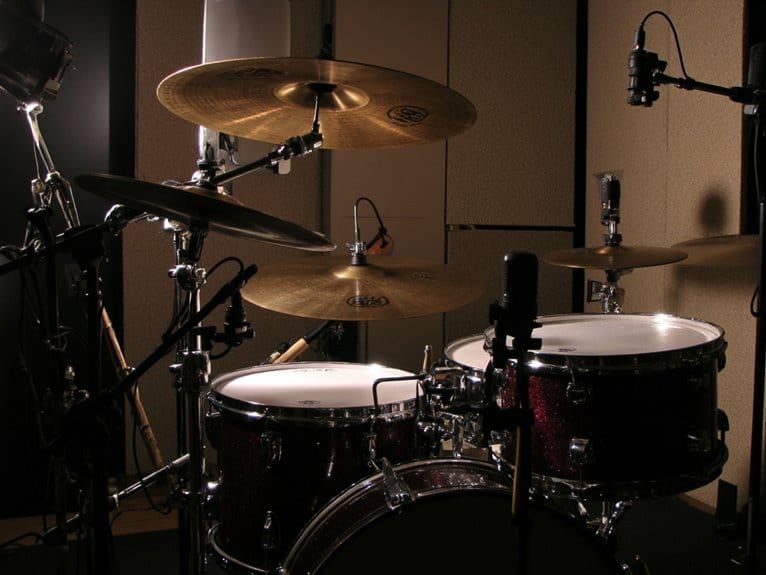Understanding Synthesizer Categories: Bass, Lead, Pad, and Arp
You’ll need to understand that synthesizers fall into four essential categories, each serving distinct musical roles in your productions. Bass synthesizers deliver earth-shaking low frequencies using analog circuits and voltage-controlled oscillators, while lead synthesizers cut through dense mixes with bright sawtooth waves and modulation techniques. Pad synthesizers create atmospheric textures through extended envelope shaping, and arpeggiator synthesizers transform chords into rhythmic sequences. Mastering these categories reveals deeper synthesis techniques that’ll transform your sound design approach.
We are supported by our audience. When you purchase through links on our site, we may earn an affiliate commission, at no extra cost for you. Learn more.
Notable Insights
- Bass synthesizers generate deep, powerful low frequencies using analog circuits and voltage-controlled oscillators for foundational groovy basslines.
- Lead synthesizers provide melodic clarity with bright sawtooth or square waves that cut through dense mixes effectively.
- Pad synthesizers create atmospheric textures using extended attack/release envelopes and various synthesis methods for immersive soundscapes.
- Arpeggiator synthesizers transform chord progressions into dynamic rhythmic sequences with sophisticated pattern manipulation and DAW synchronization.
- Each category features specialized control interfaces: bass synths emphasize filter knobs, leads prioritize expression wheels, pads use texture sliders.
Bass Synthesizers: The Foundation of Low-End Power
When you’re diving into the world of synthesizers, bass synths represent perhaps the most viscerally satisfying category, delivering those earth-shaking low frequencies that form the backbone of countless musical genres.
These powerhouses utilize analog circuits with voltage-controlled oscillators and resonant filters to craft everything from the iconic Moog Minimoog‘s warm, thick tones to the Roland TB-303’s squelchy acid basslines that defined electronic music.
Your bass sound design toolkit expands dramatically with models like the semi-modular Korg MS-20, offering extensive patching capabilities alongside traditional knob control.
The wobble dubstep bass emerged from the UK garage scene in the early 2000s, utilizing fast LFO modulation of filter cutoff frequency to create its characteristic undulating sound that became a defining element of the genre.
Whether you’re exploring vintage synthesis techniques through classic 808 sub-bass or crafting modern Reese bass textures using detuned saw waves, these instruments provide the foundational low-end power that transforms sequences into compelling musical experiences. Bass synthesizers excel at generating low-frequency sounds that deliver the deep and punchy bass tones essential for creating groovy basslines across electronic music genres.
Lead Synthesizers: Cutting Through the Mix With Melodic Presence
While bass synthesizers anchor tracks with their foundational low-end power, lead synthesizers serve the opposite but equally crucial role of slicing through dense mixes with crystalline melodic clarity and commanding presence.
Your lead sound design starts with bright sawtooth or square wave oscillators, creating sharp, cutting tones that pierce through competing frequencies without muddying the mix.
Bright oscillators cut through dense arrangements with razor-sharp precision, ensuring your melodies command attention without cluttering the sonic landscape.
I’ve found that effective modulation techniques like LFO-driven vibrato, pitch bends, and filter sweeps transform static melodies into dynamic, attention-grabbing performances.
Modern lead synths excel at expressive performance through velocity sensitivity, aftertouch control, and real-time modulation wheels, allowing you to inject personality into every melodic phrase while maintaining the focused, articulate character that defines exceptional lead synthesizer work. The Arturia MiniFreak’s 37-key polyphonic design demonstrates how modern hybrid synthesizers combine multiple oscillator types with analog filtering for versatile lead sound creation. Professional instruments like the Nord Lead series utilize digital signal processors to deliver the analog warmth and cutting power that define classic lead tones.
The Roland Tweak Synth (S-1) exemplifies how ACB technology can authentically recreate vintage analog sounds while providing modern lead synthesis capabilities for contemporary productions.
Pad Synthesizers: Creating Atmospheric Textures and Ambient Layers
Though lead synthesizers command attention with cutting melodies, pad synthesizers operate in the sonic background where they weave atmospheric textures that transform ordinary arrangements into immersive soundscapes. You’ll find that pads excel at creating those lush, sustained tones that breathe life into your mix, using extended attack and release envelopes to fade sounds in gradually rather than punching through aggressively like their lead counterparts.
| Synthesis Type | Characteristic Sound |
|---|---|
| Analog | Warm, organic warmth |
| FM | Metallic, complex timbres |
| Wavetable | Glassy, morphing textures |
| Sample-based | Realistic instrument layers |
These pad soundscapes rely on careful envelope shaping and subtle modulation to achieve ambient evolution, ensuring your atmospheric layers support the arrangement without competing for attention or overwhelming the melodic elements. Modern polyphonic synthesizers like the Arturia MiniFreak excel at hybrid synthesis that combines digital oscillators with analog filters, making them particularly well-suited for creating these lush atmospheric textures and intricate pad arrangements.
Arpeggiator Synthesizers: Rhythmic Patterns and Sequential Magic
Most synthesizers that feature built-in arpeggiators transform static chord progressions into dynamic, rhythmic sequences by automatically cycling through individual notes at precisely timed intervals, creating everything from shimmering ambient textures to driving techno basslines with remarkable simplicity.
You’ll discover that arpeggiator techniques involve more than basic note sequencing, as modern implementations offer sophisticated rhythm manipulation through gate time adjustments, swing parameters, and creative modulation possibilities that shape each step’s velocity and pitch.
Tempo synchronization guarantees your pattern generation stays locked to your DAW’s clock, while melodic variation controls like “force to scale” maintain harmonic layering consistency.
Whether you’re programming acid sequences or ambient arpeggios, these tools convert simple chord inputs into complex, evolving patterns that breathe life into otherwise static harmonic progressions.
Budget-conscious producers can access professional arpeggiator functionality through affordable options like the Behringer Pro VS Mini, which combines its built-in sequencer with 4-voice polyphony to create rich harmonic sequences without compromising sound quality.
For producers seeking deeper pattern manipulation, modular synthesizers like the Korg Volca Modular offer sophisticated 16-step sequencer capabilities that can transform basic arpeggiated patterns into intricate, evolving musical phrases through creative patching and modulation routing.
Synthesis Methods Behind Each Category
Now that you understand how different synthesizer categories create their signature sounds, it’s time to examine the synthesis methods that make each one tick, starting with subtractive synthesis fundamentals that form the backbone of most bass, lead, and pad sounds through filter-based sculpting of harmonically rich waveforms.
You’ll also discover how digital synthesis techniques like FM and wavetable synthesis contribute unique characteristics to each category, particularly excelling in lead and pad applications where complex timbral evolution becomes essential.
Modern synthesizers increasingly employ hybrid analog-digital approaches that combine the warmth of analog circuitry with the precision and flexibility of digital processing, giving you access to both classic and contemporary synthesis methods within a single instrument.
Subtractive Synthesis Fundamentals
At its core, subtractive synthesis operates like an audio sculptor’s workshop, where you start with harmonically rich raw material from oscillators and systematically carve away unwanted frequencies to reveal your desired sound. This process allows for an incredible degree of nuance and control, as each adjustment can dramatically alter the final output. By employing subtractive synthesis techniques, sound designers can shape timbres with precision, enhancing harmonic content or creating more subdued, mellow tones. The result is a versatile palette that can produce everything from rich pads to sharp leads, catering to a wide array of musical styles.
Understanding these fundamental building blocks will transform your approach to sound design, whether you’re crafting thunderous bass lines or soaring lead melodies.
The essential components work together in a predictable signal flow:
- Oscillator types generate your raw audio signal using sine, triangle, square, or sawtooth waveforms.
- Filter parameters like cutoff frequency and resonance subtract unwanted frequencies from the harmonic content.
- Envelope shaping controls how your sound evolves over time using ADSR curves.
- Modulation techniques add movement through LFOs affecting pitch, filters, or amplitude dynamically.
Digital Synthesis Techniques
While subtractive synthesis relies on filtering harmonically rich oscillators, digital synthesis techniques build sounds through mathematical algorithms, opening entirely new sonic territories that would be impossible with analog circuitry alone.
FM synthesis excels at creating metallic basses and sharp leads through frequency modulation, while wavetable synthesis morphs between stored waveforms for evolving pads and complex textures.
Additive synthesis builds tones from individual sine wave partials, offering precise harmonic control for smooth pads and focused bass fundamentals.
Sample-based synthesis combines organic transients with synthetic sustains, enabling realistic sound layering across all categories.
Vector synthesis provides dynamic blending through digital modulation, letting you morph between multiple sources for expressive performance control in leads and evolving soundscapes.
Hybrid Analog-Digital Approaches
Why choose between the warmth of analog and the precision of digital when you can have both? Hybrid synthesis approaches combine digital oscillators with analog filters, delivering synthesis advantages that neither technology achieves alone.
I’ve found these systems particularly effective for sound design, as they address tuning instability while maintaining analog character.
Here’s how hybrids excel across categories:
- Bass synthesizers use digital wavetable oscillators through analog VCFs, providing harmonic complexity with classic saturation and punch.
- Lead synths leverage digital phase modulation paired with analog envelope filtering for expressive, evolving timbres.
- Pad sounds blend digital additive synthesis with analog filter resonance, creating lush textures without digital coldness.
- Arpeggiators sequence digital oscillators through analog signal paths, combining precise timing with dynamic analog articulation.
Modern synthesizers often feature velocity-sensitive keys that enhance expressive performance across all these categories, allowing for nuanced control over attack and dynamics. Many modern hybrid synthesizers connect to recording setups through USB connectivity, enabling seamless integration with DAWs and audio interfaces for professional-quality production.
Essential Features That Define Synthesizer Categories
When you’re evaluating synthesizers across different categories, two fundamental aspects will determine how well each instrument serves your musical needs: the sound generation methods that create the actual tones, and the control interface design that lets you shape those sounds in real-time.
I’ve found that understanding these core features helps you quickly identify whether a synth excels as a bass monster, lead screamer, atmospheric pad machine, or rhythmic arpeggiator, since each category demands specific technical capabilities and user interaction approaches.
You’ll discover that the most effective synthesizers in each category aren’t just about having the right oscillators or filters, but about how those components work together through an interface that matches your performance style and workflow preferences.
Sound Generation Methods
At the heart of every synthesizer lies its sound generation method, which fundamentally determines the character, versatility, and sonic possibilities you’ll encounter when crafting your music.
Each approach creates distinct sound waveforms through different processes, establishing unique harmonic relationships that define your instrument’s personality.
Subtractive synthesis starts with rich oscillator waveforms, then sculpts them using filters to remove unwanted frequencies, producing those warm, classic tones you’ve heard countless times.
FM synthesis modulates carrier frequencies to generate harsh, glassy textures perfect for cutting leads.
Wavetable synthesis scans through digital samples, offering smooth changes between timbres, while additive synthesis combines multiple sine waves for precise harmonic control.
- Subtractive: Filters shape oscillator waveforms
- FM: Frequency modulation creates complex harmonics
- Wavetable: Digital scanning enables timbre morphing
- Additive: Sine wave combinations build custom tones
Control Interface Design
Sound generation methods provide the raw material for your synthesizer’s voice, but the control interface determines how effectively you’ll shape those sounds into musical expressions. Each synthesizer category demands specific control ergonomics that match their musical roles, and I’ve noticed that manufacturers who understand this create instruments that feel intuitive under your fingers.
Bass synths prioritize large, accessible controls for quick filter sweeps during performance, while lead synths emphasize pitch bend wheels and aftertouch for expressive solos. Pad synths feature grouped sliders for texture morphing, and arp synths integrate dedicated step sequencing buttons.
| Control Type | Bass Synths | Lead Synths | Pad Synths |
|---|---|---|---|
| Primary Controls | Large filter knobs | Pitch/mod wheels | Texture sliders |
| Display Feedback | Simple LED | Full-color screen | Graphical layers |
| Tactile Elements | Sturdy switches | Velocity keys | Smooth rotaries |
| Performance Focus | Quick tweaks | Real-time expression | Evolving sounds |
| User Feedback | Minimal visual | Detailed waveforms | Modulation graphics |
Adequate user feedback through visual displays and tactile responses guarantees you’ll maintain creative flow without constantly checking screens.
Frequently Asked Questions
Can One Synthesizer Effectively Handle All Four Categories or Do I Need Separate Instruments?
You can find synths with excellent versatility handling all four categories, though dedicated instruments often excel more. Modern all in one options like polysynths and semi-modular units effectively cover bass, lead, pad, and arp needs.
What’s the Typical Price Range for Beginner-Friendly Synthesizers in Each Category?
You’ll find beginner synthesizer prices typically range from $300-$700 across categories. Bass synths start around $350, leads run $400-$700, pads span $350-$700, and affordable synth options for arpeggiation cost $300-$650.
Which Synthesizer Category Should Complete Beginners Start Learning First?
You should start with bass synths since they’re typically monophonic, simplifying your learning experience. Bass synthesis techniques teach fundamental oscillator and filter concepts, creating a solid foundation before advancing to more complex lead sound design and polyphonic instruments.
On a final note
You’ve now got the roadmap to navigate synthesizer categories with confidence, whether you’re crafting thunderous basslines, soaring leads, ethereal pads, or hypnotic arpeggiated sequences. Each category serves distinct purposes in your sonic arsenal, and understanding their unique characteristics, synthesis methods, and essential features will help you make informed decisions when selecting instruments. Start experimenting with these foundational concepts, and you’ll discover how each synthesizer type contributes to your musical vision.

